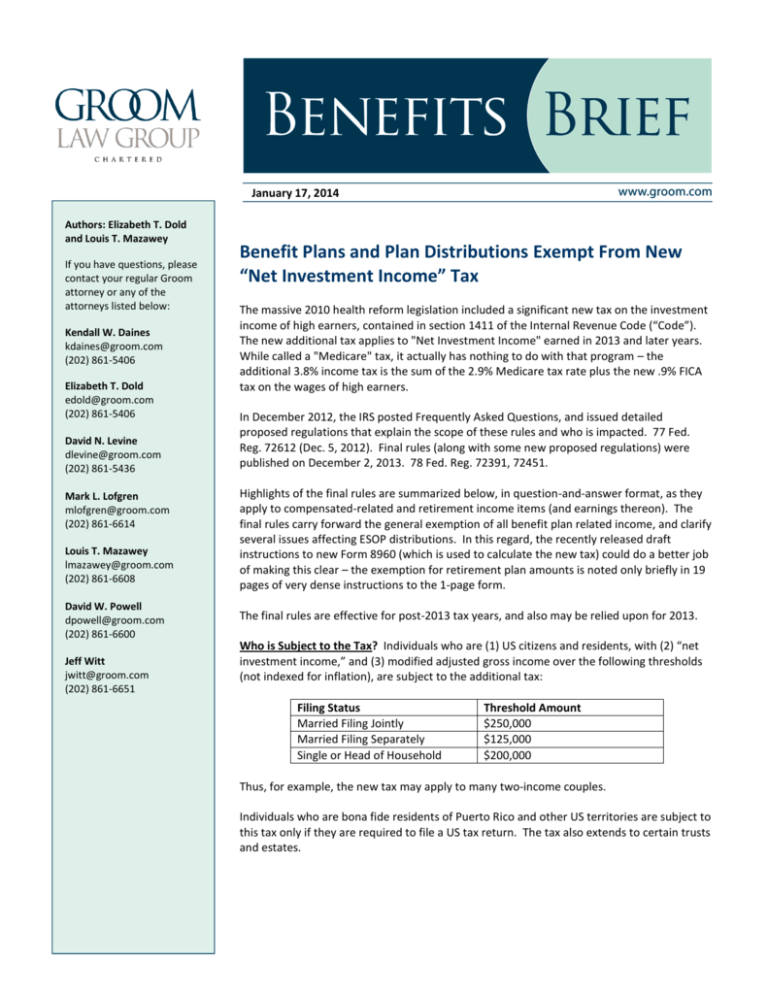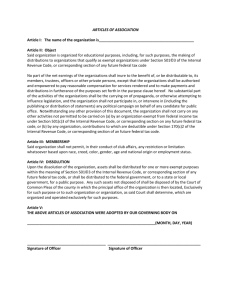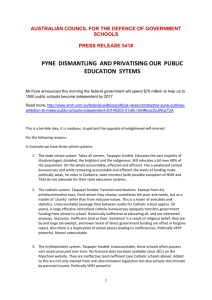
January 17, 2014
Authors: Elizabeth T. Dold
and Louis T. Mazawey
If you have questions, please
contact your regular Groom
attorney or any of the
attorneys listed below:
Kendall W. Daines
kdaines@groom.com
(202) 861-5406
Elizabeth T. Dold
edold@groom.com
(202) 861-5406
David N. Levine
dlevine@groom.com
(202) 861-5436
Mark L. Lofgren
mlofgren@groom.com
(202) 861-6614
Louis T. Mazawey
lmazawey@groom.com
(202) 861-6608
David W. Powell
dpowell@groom.com
(202) 861-6600
Jeff Witt
jwitt@groom.com
(202) 861-6651
Benefit Plans and Plan Distributions Exempt From New
“Net Investment Income” Tax
The massive 2010 health reform legislation included a significant new tax on the investment
income of high earners, contained in section 1411 of the Internal Revenue Code (“Code”).
The new additional tax applies to "Net Investment Income" earned in 2013 and later years.
While called a "Medicare" tax, it actually has nothing to do with that program – the
additional 3.8% income tax is the sum of the 2.9% Medicare tax rate plus the new .9% FICA
tax on the wages of high earners.
In December 2012, the IRS posted Frequently Asked Questions, and issued detailed
proposed regulations that explain the scope of these rules and who is impacted. 77 Fed.
Reg. 72612 (Dec. 5, 2012). Final rules (along with some new proposed regulations) were
published on December 2, 2013. 78 Fed. Reg. 72391, 72451.
Highlights of the final rules are summarized below, in question-and-answer format, as they
apply to compensated-related and retirement income items (and earnings thereon). The
final rules carry forward the general exemption of all benefit plan related income, and clarify
several issues affecting ESOP distributions. In this regard, the recently released draft
instructions to new Form 8960 (which is used to calculate the new tax) could do a better job
of making this clear – the exemption for retirement plan amounts is noted only briefly in 19
pages of very dense instructions to the 1-page form.
The final rules are effective for post-2013 tax years, and also may be relied upon for 2013.
Who is Subject to the Tax? Individuals who are (1) US citizens and residents, with (2) “net
investment income,” and (3) modified adjusted gross income over the following thresholds
(not indexed for inflation), are subject to the additional tax:
Filing Status
Married Filing Jointly
Married Filing Separately
Single or Head of Household
Threshold Amount
$250,000
$125,000
$200,000
Thus, for example, the new tax may apply to many two-income couples.
Individuals who are bona fide residents of Puerto Rico and other US territories are subject to
this tax only if they are required to file a US tax return. The tax also extends to certain trusts
and estates.
What is Net Investment Income? In general, investment income includes interest, dividends, capital gains, rental and
royalty income, taxable distributions from non-qualified annuities, income from businesses involved in trading
financial instruments or commodities, and income from passive activities. However, income derived in the ordinary
course of an active trade or business is generally exempt. To calculate net investment income, the investment
income is reduced by certain expenses properly allocable to the income, including investment income expense,
investment advisory and brokerage fees, expenses related to rental or royalty income, and state and local income
taxes.
The tax does not apply to income that is excluded from gross income for regular income tax purposes (e.g., taxexempt interest, life insurance proceeds, and certain gain from sale of principal residence). In general, all "wages,"
"self-employment income" (e.g., director's fees and insurance agent's commissions), alimony, and social security
benefits are also exempt.
How Are Retirement Income and Plans/Trusts Treated? All income earned under – and all distributions from – taxfavored retirement plans (plans described in Code sections 401(a), 401(k), 403(a), 403(b), and 457(b)), and from IRAs
(traditional, Roth, SEP, SARSEP, and SIMPLE), are exempt. This includes deemed distributions (e.g., loan defaults,
Roth conversions), corrective distributions (e.g., “excess deferral” failure, excess IRA contributions), and any amount
that is not treated as a distribution, but is otherwise includible in gross income from an IRA or qualified plan (e.g.,
"P.S. 58" costs from life insurance).
The final rules clarify, in a favorable manner, several issues affecting employer stock held under ESOPs and other
qualified plans. Specifically –
Qualified dividends on employer stock held under ESOPs, which are deductible by the employer under Section
404(k), are not subject to the new tax (even though other dividends are) when distributed to participants.
However, after the employer stock has been distributed, dividends paid on the stock will be subject to the
additional tax.
“Net unrealized appreciation” (“NUA”) on employer stock is excluded from income at the time the stock is
distributed in a qualified distribution – typically, in a total distribution, or to the extent the stock was purchased
with after-tax employee contributions. Such “NUA” is also exempt from the tax on net investment income –
even if it is later taxed when the stock is sold. However, any stock appreciation earned post-distribution will be
subject to the new tax.
It is important to note that, even if some of a qualified plan's investment income is taxable under the unrelated
business income tax rules (e.g., rental income from a leveraged real estate investment under Code sec. 514), the new
tax does not apply to the plan. The same principle applies to income earned by VEBAs and other benefit trusts
exempt under section 501 of the Code – even if some income is potentially subject to UBIT on “excess” reserves – as
well as health savings accounts and qualified tuition savings accounts.
What About Nonqualified Plan Arrangements? Amounts paid to an individual (or which are otherwise includible in
income under Code sections 409A, 457(f), 457A, or other Code section or tax doctrine) that include gross income
from interest, dividends, or other earnings are not treated as net investment income – regardless of whether such
amounts were subject to FICA (or SECA). This generally reflects the principle that income attributable to the
performance of services is not subject to the additional tax – even if its source includes items of investment income
(e.g., interest credited on deferred compensation). Consistent with this principle and many tax treaties, the final
2
This publication is provided for educational and informational purposes only and does not contain legal advice. The information should in no way be taken as an indication of future legal
results. Accordingly, you should not act on any information provided without consulting legal counsel. To comply with U.S. Treasury Regulations, we also inform you that, unless expressly
stated otherwise, any tax advice contained in this communication is not intended to be used and cannot be used by any taxpayer to avoid penalties under the Internal Revenue Code, and such
advice cannot be quoted or referenced to promote or market to another party any transaction or matter addressed in this communication.
© 2013 Groom Law Group, Chartered • 1701 Pennsylvania Ave NW • Washington, DC 20006. All rights reserved.
rules expressly exclude from this tax distributions from foreign pension plans paid for services rendered (even though
income from non-qualified annuities taxed under Code section 72 generally is subject to the new tax).
How is the Tax Computed? The tax equals 3.8% times the lesser of (i) taxpayer's adjusted gross income - threshold,
or (ii) net investment income. Some examples –
Taxpayer, a single filer, has wages of $180,000 and $15,000 of dividends and capital gains. Taxpayer's modified
adjusted gross income is $195,000, which is less than the $200,000 statutory threshold. Taxpayer is not subject
to the Net Investment Income tax.
If the single Taxpayer instead has $195,000 of wages and $15,000 of investment income (total AGI of $210,000),
$10,000 of the investment income would be subject to the new tax – for an additional tax of $380.
How is the Tax Reported and Paid? Payors of net investment income are not required to withhold the tax. An
individual reports and pays the tax with his or her Form 1040. Notwithstanding commentators requesting
exemption, the final rules confirm that the tax is also subject to the estimated tax provisions, including possible
penalties for underpayment for 2013 (as well as future years). Therefore, if a material amount of net investment
income is expected, the taxpayer should either increase income tax withholding (Form W-4/W-4P) or make estimated
tax payments to avoid underpayment penalties.
What Actions Should Taxpayers Consider to Minimize the New Tax? The new rules draw a pretty clear line ensuring
that income related to compensations for services – and to tax-favored retirement, education and health programs –
will not be subject to the added burden of the new tax. On the other hand,
The maximum tax rate on interest income is 39.6%, resulting in a total tax rate of 43.4%, inclusive of this new tax.
The tax rate on long-term capital gains and “qualified dividends” is 20%, resulting in a total tax of 23.8%, inclusive
of the new tax.
Thus, higher income taxpayers who can dedicate substantial savings to long-term retirement, etc., programs (and
who are not already at the limits) would be well-advised to do so. This includes, for example, making the full amount
of allowable non-deductible IRA contributions.
The changing tax landscape may also prompt employers to review their qualified and non-qualified programs to be
sure they are as tax efficient as possible.
3
This publication is provided for educational and informational purposes only and does not contain legal advice. The information should in no way be taken as an indication of future legal
results. Accordingly, you should not act on any information provided without consulting legal counsel. To comply with U.S. Treasury Regulations, we also inform you that, unless expressly
stated otherwise, any tax advice contained in this communication is not intended to be used and cannot be used by any taxpayer to avoid penalties under the Internal Revenue Code, and such
advice cannot be quoted or referenced to promote or market to another party any transaction or matter addressed in this communication.
© 2013 Groom Law Group, Chartered • 1701 Pennsylvania Ave NW • Washington, DC 20006. All rights reserved.







